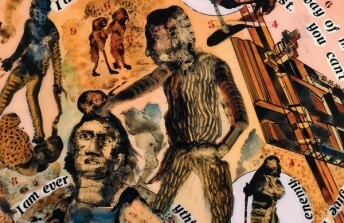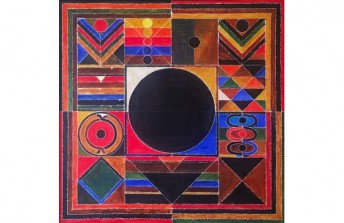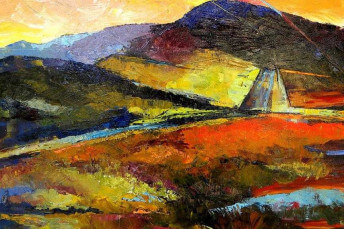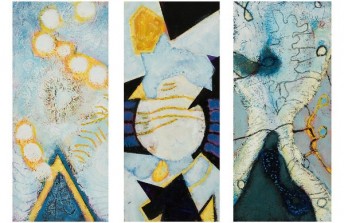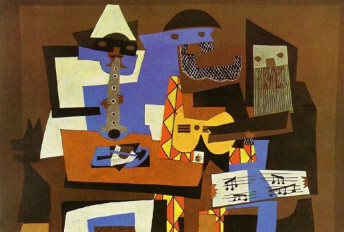Ram Kumar, India's Foremost Abstract Artist, Dies
Apr 20, 2018
Ram Kumar, one of the last two surviving members of the Bombay Progressive Artists Group (PAG), has died at age 93. Along with the other seven members of the group, Kumar was instrumental in encouraging the growth of an Indian avant-garde in the mid-20th Century. The Bombay PAG was formed in 1947, at around the same time as the partition of India. The prevailing artistic trend of the time favored realistic, traditional images associated with a sort of revived brand of historic nationalism. Kumar and his contemporaries felt drawn to the emerging Modernist art styles that had evolved in Europe, and were interested in seeking ways to combine those aesthetic approaches with something that could be called uniquely Indian. Kumar emerged as one of the leaders of the group, eventually gaining a reputation as the greatest living Indian painter. His luxurious and textured abstract landscapes evoke powerful emotion, especially from Indian audiences who recognize the references Kumar often made to the changing natural surroundings of contemporary India. He was adept at capturing what many consider to be the spirit of his time—a mixture between the beauty and optimism of progress, the sad nostalgia for lost nature, and the widespread social anxiety brought on a rapidly developing urban world torn between extremes of poverty and wealth. His paintings are among the most expensive ever sold by an Indian artist, topping more than one million dollars at auction. His death leaves Akbar Padamsee, age 90, as the last living member of the PAG.
The Accidental Painter
Ram Kumar grew up in a family of eight children. As a testament to how much times have changed since then, his father was a government employee, and yet this family of ten was still considered middle class. Kumar was educated to be a banker. However, in the midst of earning his masters degree in economics in 1945, he haphazardly walked into an art exhibition one day. He became intrigued by the works on view, and recalled returning to the exhibition many more times to look more closely at the work. The images inspired him to start taking art classes. After studying art for three years, he announced to his family that he was going to quit his banking job and become an artist. He borrowed money from his father for a plane ticket to Paris in 1948, the year after Indian partition, and embarked on his new life. While in Paris, he became exposed to the work of Post Impressionist, Cubist, Surrealist, and Expressionist works, as well as to the work of emerging Post War European artists.

Ram Kumar - Untitled, 1989, Acrylic on Paper, 23 1/10 × 17 9/10 in, 58.7 × 45.5 cm, Sanchit Art, New Delhi, © Ram Kumar
Kumar absorbed all of these influences and masterfully incorporated their visual theories into his work. Early Modernism is especially evident in the work he made during the early years of his career, when he freely incorporated human figures in his paintings. His style of figuration was heavily influenced by artists like Picasso, Miro, and Modigliani. Even so, though the figures in the work were realistic, the landscapes in which the figures dwelt were fragmented and warped. The figures seem isolated and disturbed, while the world around them seems to be untethered to anything firm. Kumar took visual tendencies of European Modernism but interpreted them through his personal point of view. As time went on, the figures became less frequent, and the landscapes became more and more abstract. Soon, he had developed a distinct visual language of muted earth tone, textured surfaces, and rough-hewn abstract shapes distinct from anything he had seen in Paris.
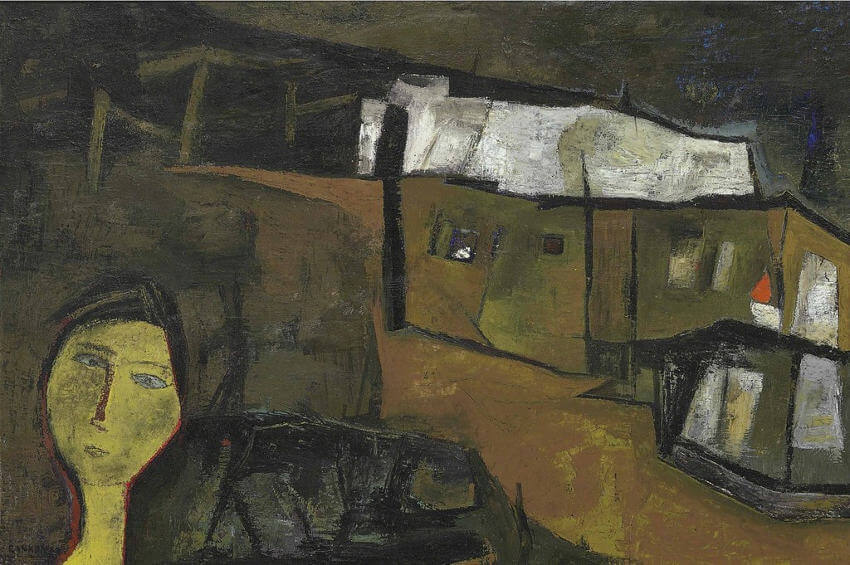
Ram Kumar - Composition, 1958, Oil on canvas, 23 2/5 × 35 in, 59.4 × 88.9 cm, © Ram Kumar
Delicate and Disturbing
Indian art critics often describe Kumar as being as much like a poet as a painter. They reference both the tranquility and the suffering that is evident in so many of his paintings. His nuanced color palette and sensuous handling of paint convey something delicate and loving. At the same time, there is an obvious element of darkness in all of his works. The color combinations seem to convey extremes of heat or cold. There is an unmistakable barrenness to his compositions. The relationships between the shapes and forms makes viewers feel isolated. The textures evoke a sense of destitution or degradation. Many writers have looked to these factors as evidence that Kumar was somehow attempting to capture that angst that often defines contemporary Indian culture, which is an effect of being torn between progress and tradition. The poetry so often described when writing about the work lies chiefly in that contradiction.

Ram Kumar - Untitled Landscape (House), 2003, Oil on canvas, 36 × 36 in, 91.4 × 91.4 cm, Aicon Gallery, New York, © Ram Kumar
Kumar, however, was less interested at the end of his life in filling his work with any kind of social content, or for that matter poetry. Late in life he was quoted as saying, “When one is young and beginning, one’s work is dominated by content, by ideas, but as one grows older, one turns to the language of painting itself. I have grown detached. I want to find the same peace that the mystics found.” By the end of his life his abstract landscapes had evolved into purely abstract compositions in which complex, dramatic, and layered spatial relationships play out in illusionary space. They are painterly, and clearly created by a masterfully trained artist. If his words are to be believed, these works should be appreciated purely according to their formal aspects, which are formidable. It seems to me either way of interpreting them is acceptable. I cannot help but become contemplative when admiring these images. The artist was intimately familiar with the aspects of Indian life that are delicate and serene. And yet his youthful dreams of progress have frequently been upended in the past 70 years. A distinctive Indian aesthetic has indeed emerged, largely because of his work. A major part of that aesthetic, in my opinion, lies in the mystery of how we choose to interpret what we see.
Featured image: Ram Kumar - Untitled, 1982, Acrylic on paper, 22 × 28 in, 55.9 × 71.1 cm, Vadehra Art Gallery, New Delhi, © Ram Kumar
All images used for illustrative purposes only
By Phillip Barcio

